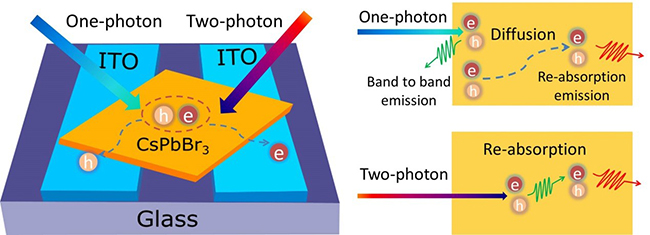
Perovskite single crystal, with low trap-state density, can be a good candidate for fabricating photodetectors with high R and fast response. However, the photodectors with centimeter-size preovskite crystal show poor performance (R< 10 A/W), due to the device size which is about three orders of magnitude larger than the charge carrier diffusion length (μm), and the charge carriers cannot be extracted efficiently.
The research group led by HAN Keli from Dalian Institute of Chemical Physics (DICP) of Chinese Academy of Sciences used a solution growth method to prepare monocrystalline CsPbBr3 micro-crystals (MCs) with low trap-state density. This work was published in Advanced Materials.
By using time-resolved photoluminescence (PL), spectroscopy under one-photon excitation (OPE) and two-photon excitation (TPE), researchers studied the photophysical properties of the CsPbBr3 MCs. Under OPE, the PL exhibited double peak emission and the PL decay dynamics showed a wavelength dependence. Compared to OPE, the TPE PL showed single emission peak with longer PL lifetime. Moreover, the TPE PL decay was wavelength independent which is different from OPE.
They concluded that the PL properties with OPE were caused by the fast carrier diffusion and the CsPbBr3 MCs exhibited high carrier mobility (over 100 cm2V-1S-1). The CsPbBr3 MCs based photodetector exhibited high R up to 6×104 A/W (D*~1013) with OPE, this is the highest value among AIP based photodetectors. The photodetectors also exhibited fast response time (~1 ms), which corresponds to a gain of ~105 and a gain-bandwidth up to 108 Hz.
Furthermore, the CsPbBr3 MCs based photodetectors showed high R up to 6 A/W in near-infrared (NIR) region under TPE.
This work was supported by the key research project of National Natural Science Foundation.

Schematic of the CsPbBr3 MC-based photodetector (Image by BIN Yang)

86-10-68597521 (day)
86-10-68597289 (night)

86-10-68511095 (day)
86-10-68512458 (night)

cas_en@cas.cn

52 Sanlihe Rd., Xicheng District,
Beijing, China (100864)

